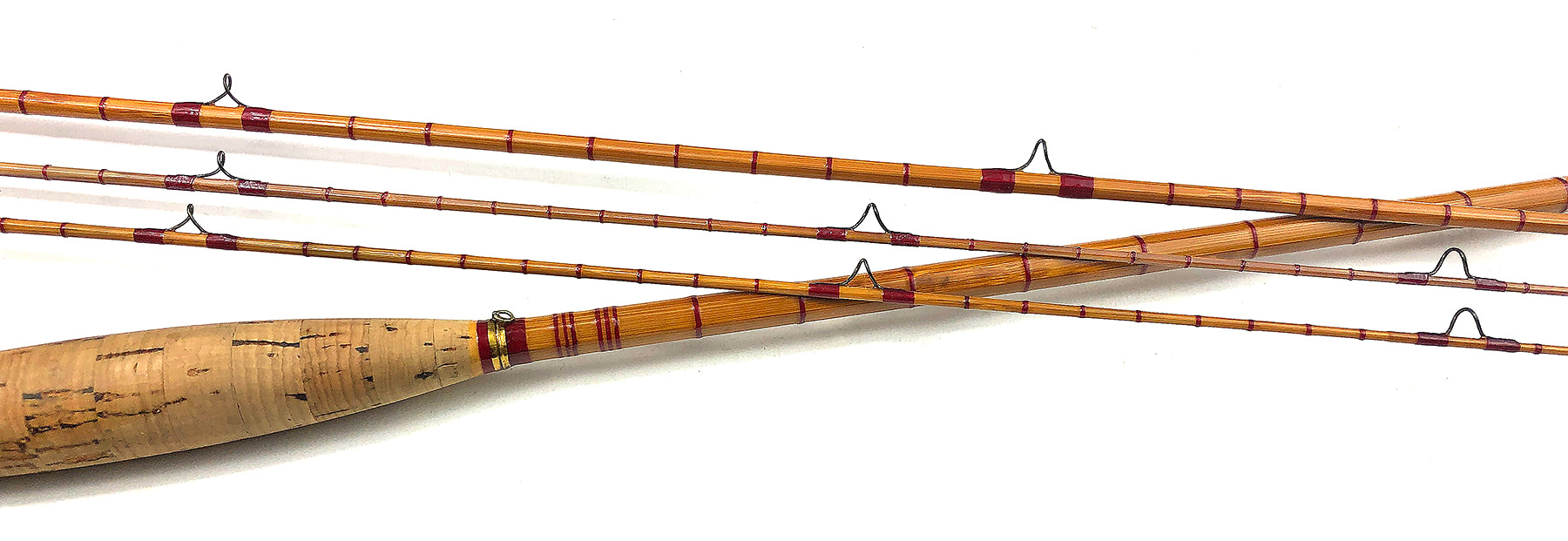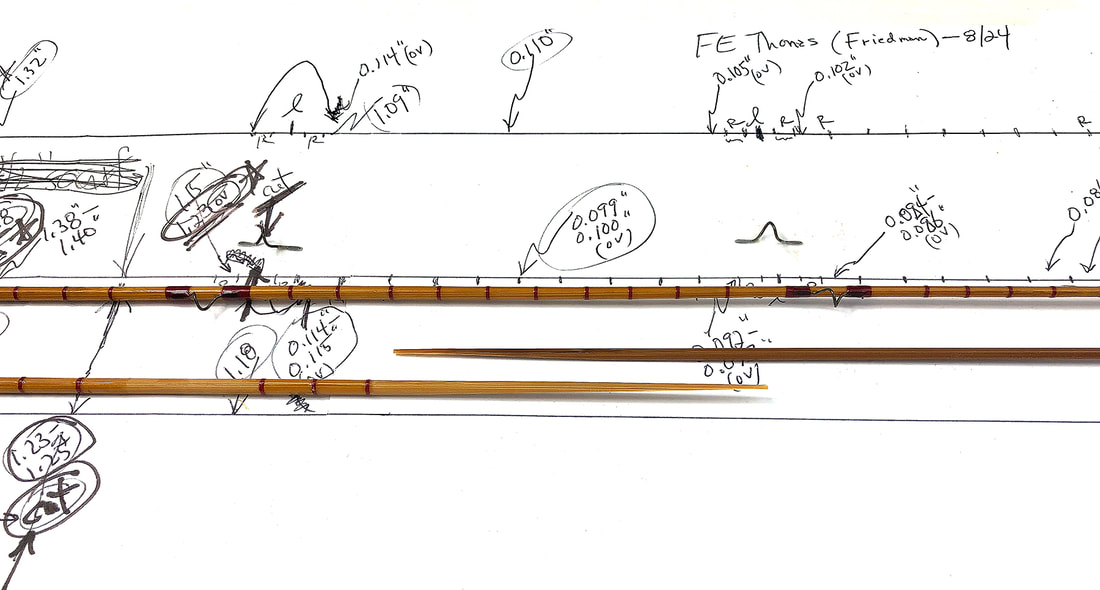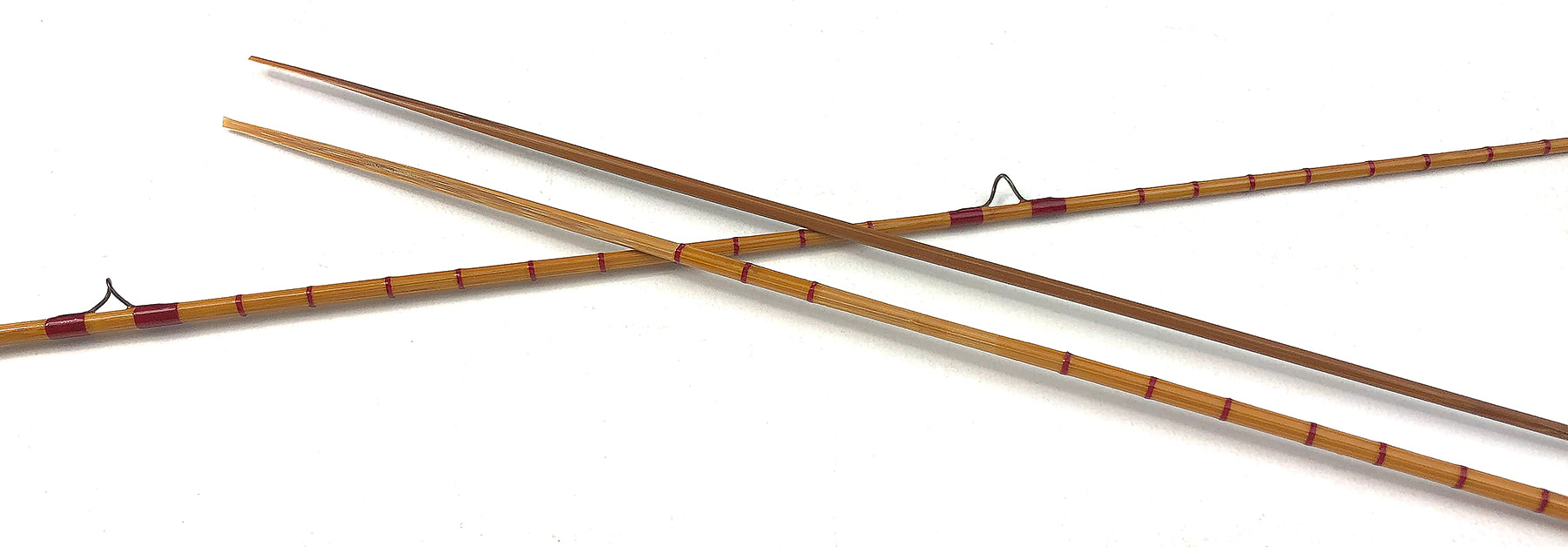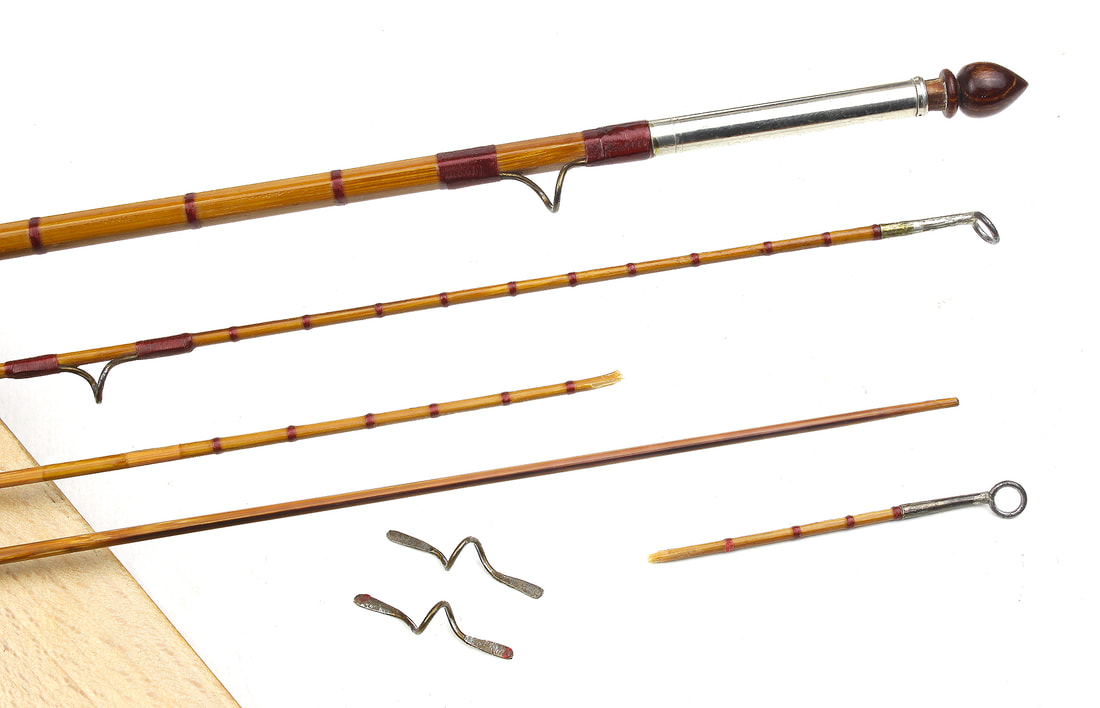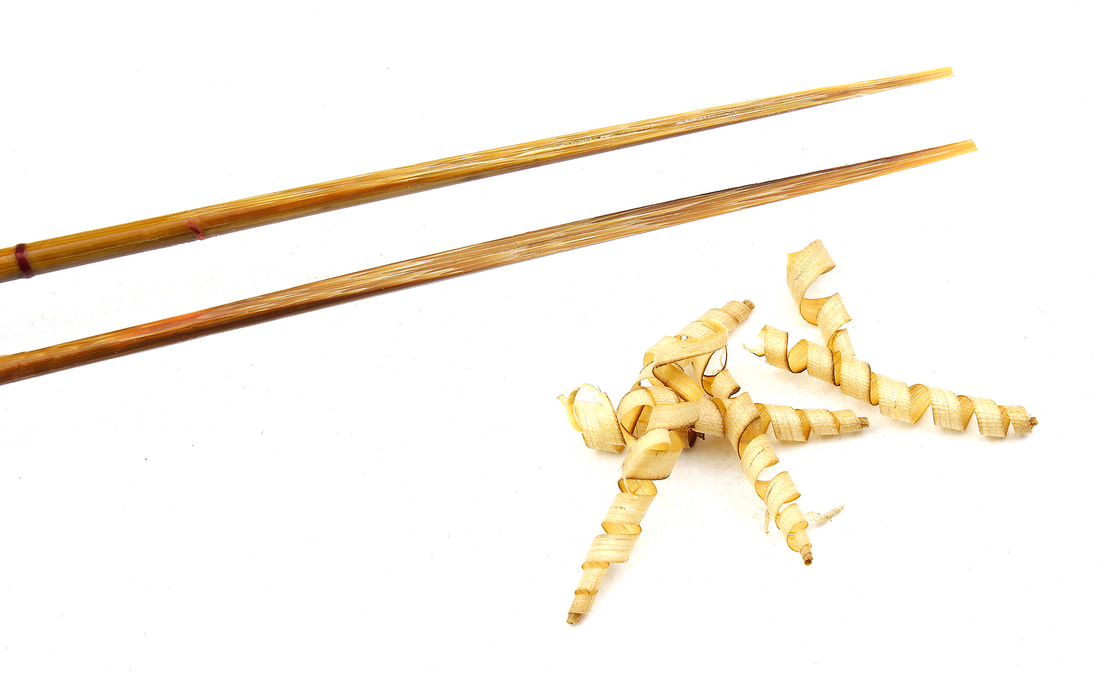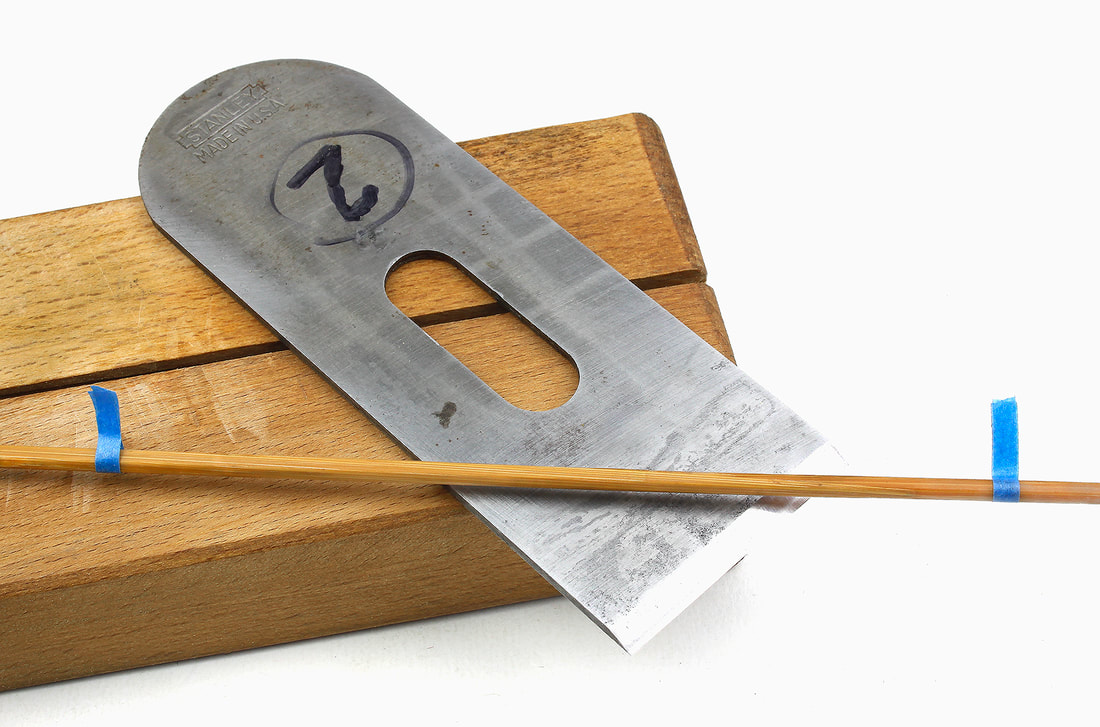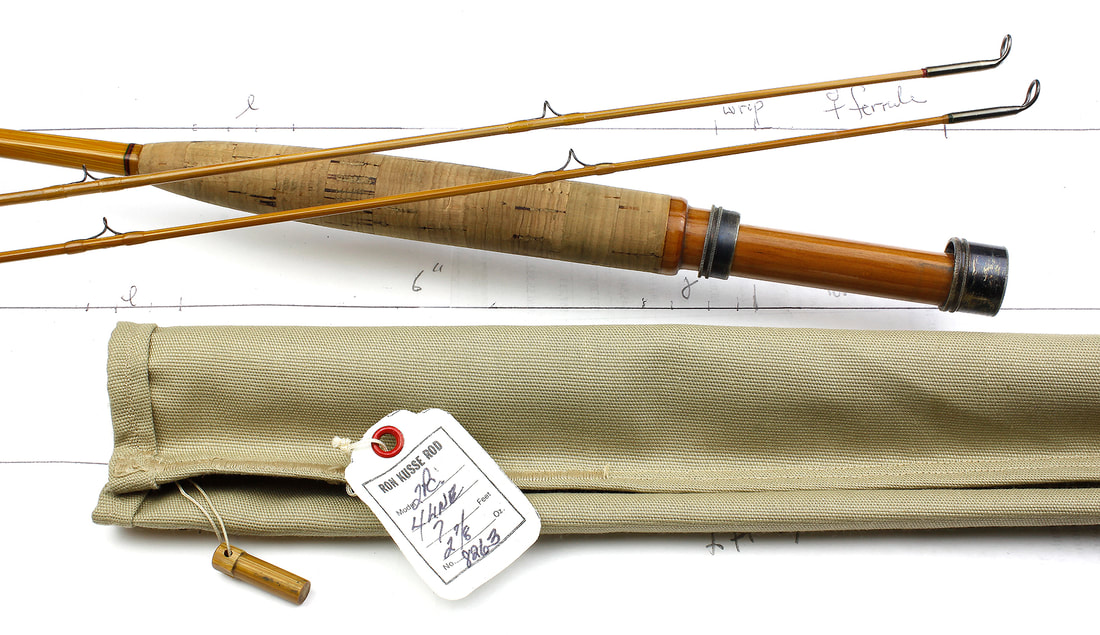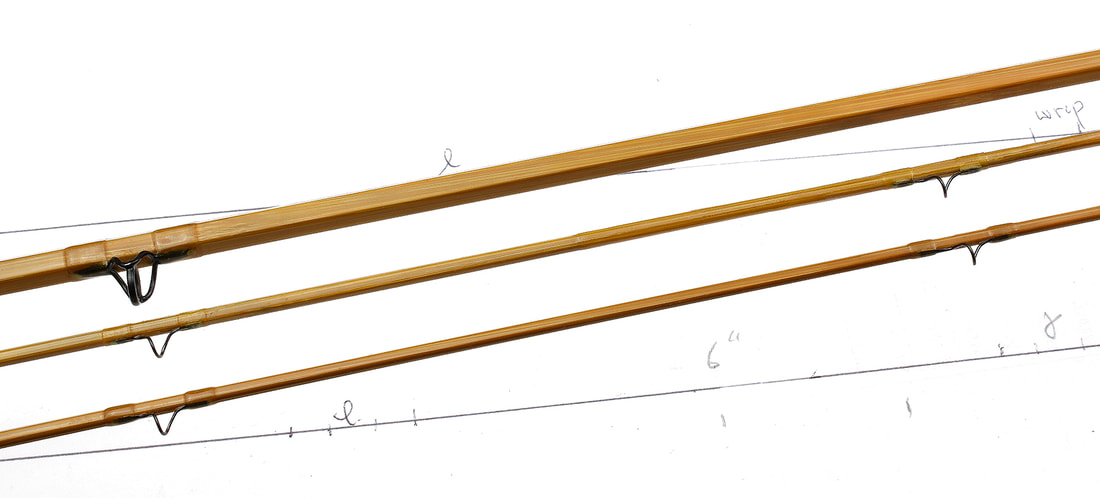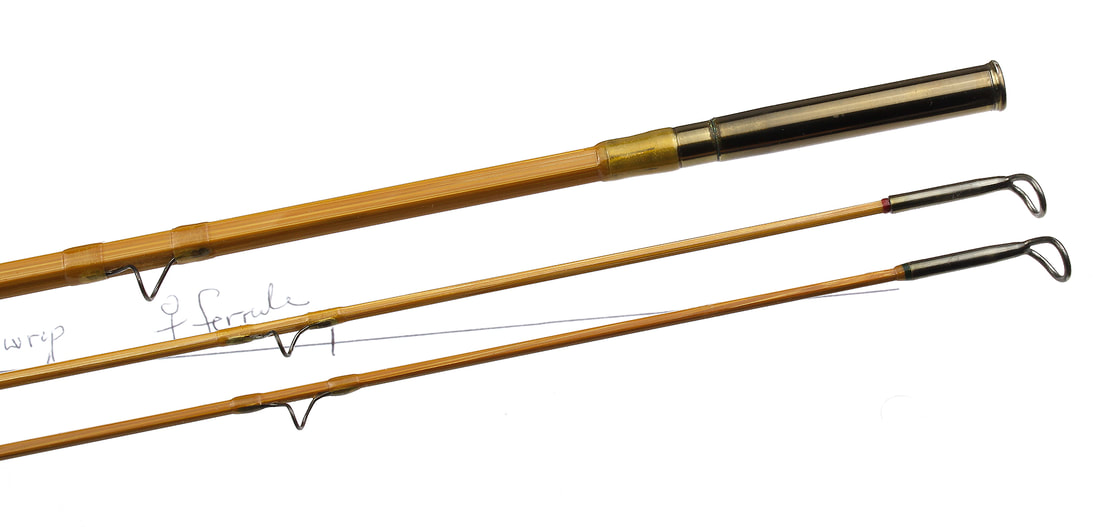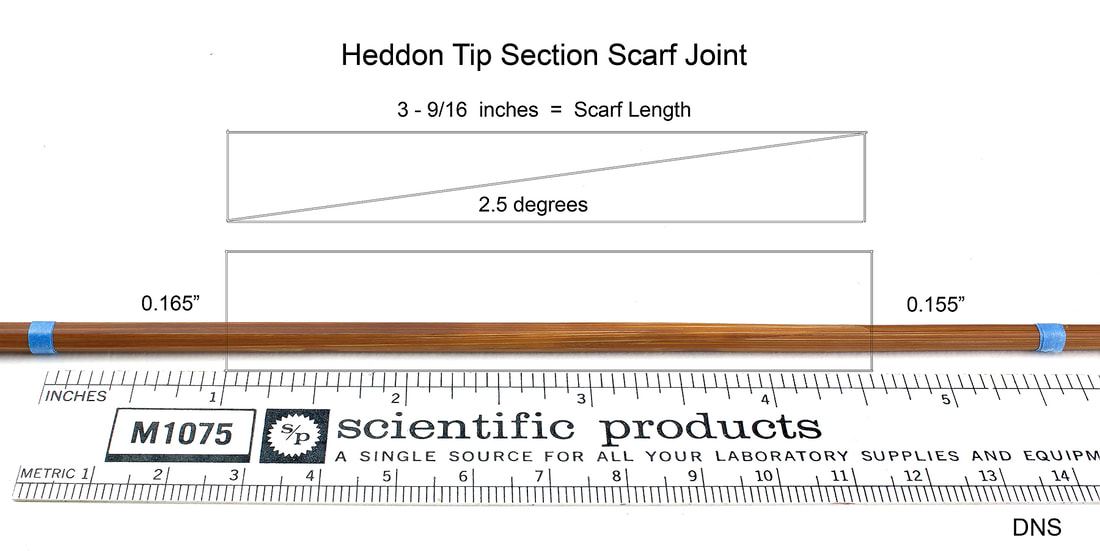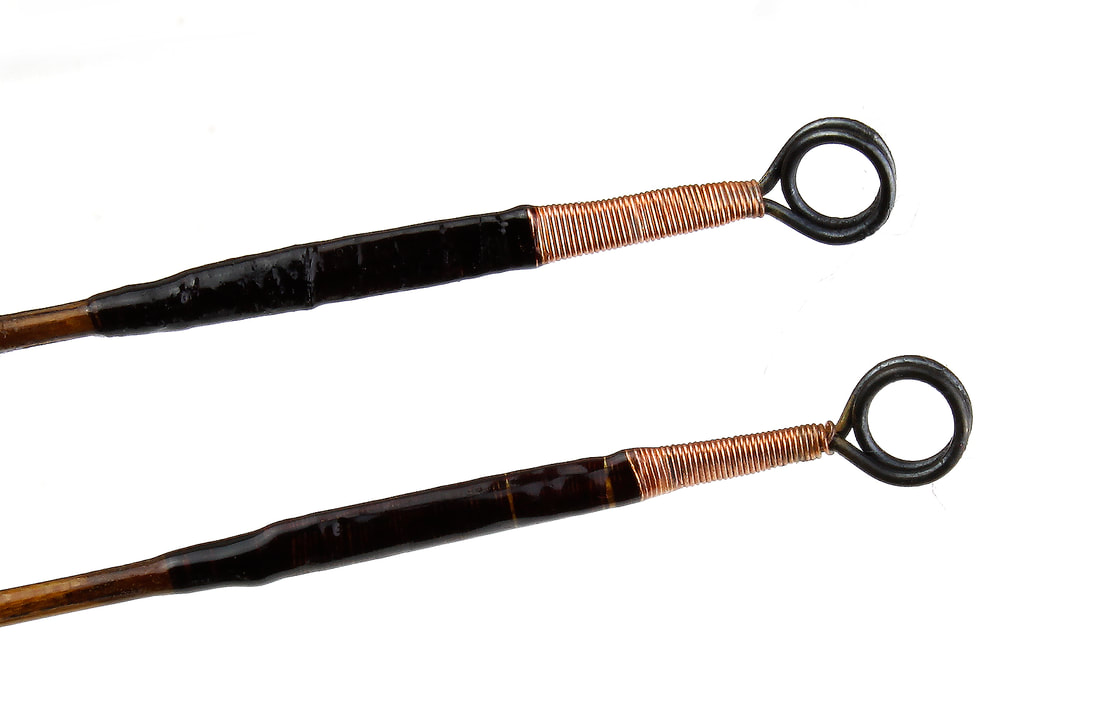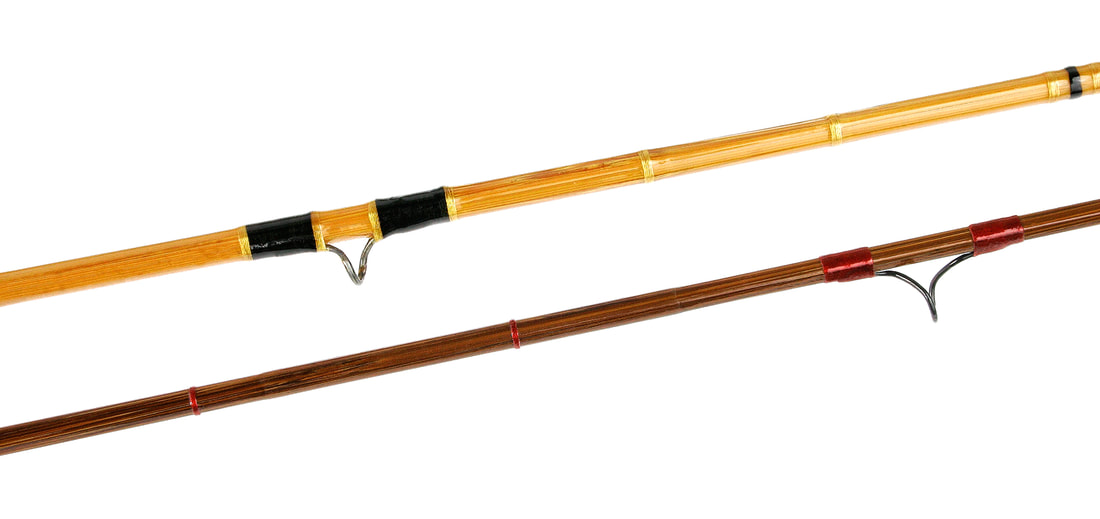Current Repairs |
"A master bamboo rod restoration & repair service. Superior quality work, excellent communication, reliable and trustworthy." J. Dudley, Tacoma, WA |
Another FE Thomas Fine Tip Scarf
FE Thomas 'Special' fly rod, 9 ft, ca 1913, 3/2 (continued from Home page) 12-24
|
Beautiful 9 foot early FE Thomas rod is lightweight & supple, w/ fine tips allowing it to cast well w/ both 5 & 4 wt lines. Rod owner reported he preferred the newly scarfed tip to the original full tip for casting, & liked a 4 or 4-1/2 wt silk line for greater line speed.
|
|
Diagram at left shows scarf joint planning process: original full tip above, short (broken) tip below & darker almost identical taper cane used to extend the tip.
Although it is possible to scarf a tip section very near the rod tip, it is often prudent to move the scarf joint down to an area w/ more cross section. [This results in a stronger & more secure glue joint. Please see Scarf Joints page for principles.] |
Measurement of diameters along the taper of the full tip revealed differences from measurements of the short tip. Although matching the taper of the original tip is important, of paramount concern is that the dimensions at both end of the scarf joint match very closely. To this end, the joint was shifted 2 in left on the short tip, so that the base of the joint would be 0.123" on both sections. The forward end of the joint was 0.115" on both sections, resulting in good match & fit of the joint.
|
...more text & photographs to come |
"Mark pinned the butt cap, tightened the mid ferrule, removed sets, & scarfed one tip on historic 1913 FE Thomas Special. His work was meticulous, but most important, invisible... You would never know he had been there." J.B. Friedman, Columbus, OH |
FE Thomas Fine Tip Scarf
Early FE Thomas 'Staggered Ferrule' fly rod, 7 ft 9 in, 3/2, Tip Scarf (in progress 8-23)
When my good friend, Portland rodmaker Dwight Lyons, referred his NM friend for scarf work, I was excited. The rod in question was a rare FE Thomas prototype w/ staggered butt ferrule, a design Thomas did not continue. The rod was purchased from renown rod dealer & author Marty Keane, & is a beautiful lightweight 7 ft 9 in w/ ring tip tops. The unfortunate break was 3 inches down on the 2nd tip.
|
First step was to remove the top 2 snake guides and the close intermediates in the break area. The scarf joint was positioned 8 to 11 inches from the tip top, w/ nominal cane diameter 0.105" providing more gluing surface.
A suitable donor section w/ correct cane diameters was located. W/ a newly sharpened plane blade, the scarf tapers were carefully cut, creating a joint 2-3/4" in length. The resulting scarf ratio of 26:1 would give the new tip excellent strength. |
Leonard Fine Tip Scarf
Vintage Leonard fly rod, 9-1/2 ft, 3/1, date unknown, Tip Scarf w/o guide wraps / invisible wrap (completed 5-23)
|
When a dear friend & Connecticut rod restorer inquired about my scarfing a vintage 9-1/2 ft Leonard tip, I offered it as a belated Birthday /Christmas gift. We often share vintage silk & components, & I felt grateful I could repay his many past favors.
Occasionally I get a scarf order from an owner skilled enough to re-wrap & varnish a rod, so I am relieved of the task of retouching & varnishing the cane after the joint is cut, glued & fared. And since the new guide positions are yet to be determined, the decision whether to do an 'invisible wrap' remains open... As is normal with fine tip scarfs, I recommended placing a guide wrap at the forward end of the scarf for added stability in this fine diameter tip. ...more text & restored rod photographs to come |
Sharpes Tip Scarf
Sharpes Spiced Joint fly rod, 12 ft, 6-23
The fractured tip of an elegant 12 ft Sharpes spey rod provided a new scarfing experience. Rather than try to locate an impregnated cane section (Sharpes or other) to extend the tip, broken a full 1-1/2 ft from the tip top, the owner suggested simply scarfing the broken tip back to the primary cane. Although losing approx 6 inches in length due to the scarf joint, the rod would still function well with this shorter tip he reasoned.
Cutting the joint required using the mid-section scarfing block due to the large diameters involved, & the joint length was almost 7 inches, to provide the usual 1:20+ scarf ratio for full strength.
Cutting the joint required using the mid-section scarfing block due to the large diameters involved, & the joint length was almost 7 inches, to provide the usual 1:20+ scarf ratio for full strength.
|
The diameter of the cane at base end of the joint was distinctly larger than the diameter at the tip end, due to the rapid taper in the Sharpes tip. After gluing, the joint required sonsiderable faring to smooth the edges of the joint, & provide a provide a smooth continuous taper. Original guides were re-wrapped, & varnish was applied to the full area of the joint.
|
Tip Scarf w/ "Invisible Wrap"
Ron Kusse fly rod, 7 ft, 2-7/8 oz, 2/2, ca 1982, Tip Scarf w/ 'Invisible Wrap' (completed 1-22)
|
The opportunity to work on this Ron Kusse rod brings me full circle... In the mid 1970's living south of NY's Catskill Mts, I visited Ron in the Leonard shop on many a winter afternoon. Always voluble, & generous to a fault, Ron regaled us w/ stories of his friend Jim Payne, & of fly casting for blues on Long Island Sound.
After leaving Leonard in the early 1980's, Ron set up his own shop in Washingtonville, NY, & began making fine, lightweight, fast action rods, using all the skills & knowledge he had learned at Leonard & Payne. To be asked to scarf the delicate tip of this Ron Kusse rod, & bring it back to full length, was an unexpected honor & brought back many memories... ...more text to come |
Tip Scarf w/o "Invisible Wrap"
Granger (W&M) fly rod, #8642, 8-1/2 ft, 3/2, ca 1948, Tip Scarf (completed 4-22)
|
Later Granger 'Victory' w/ badly splintered 2nd tip section was received for scarfing to full length. Happily, Granger tip sections were available from which to obtain matching cane for the tip extension.
[more text to come] |
Tip Repair w/ "Invisible Wrap"
H & I, 9 ft, Valise Rod, ca 1930's, Tip Straightening & Repair + Ferrule Re-Sets (completed 6-21)
|
|
Vintage 1930's H&I "Valise Rod" was purchased for backpacking trips into the Washington Cascades. These multi-piece rods sometimes seem to be "all ferrules", referring to their frequent condition of all being loose! Although true of this rod, cane & ferrule quality were good, & ferrule fit was excellent.
After re-setting four ferrules, the tip section, which had suffered from a severe twist & slight de-lamination in its top 2", was addressed. After straightening the twist & bend, an "invisible wrap" of fine white silk was wound over the damaged area, & coated w/ light epoxy. After a second light coat, the surface was fared in & smoothed, followed by several coats of thinned varnish. During test casting w/ Cortland Sylk DT5F line, the rod performed admirably, ready for high mountain waters. |
Reel Seat Replacement
Shakespeare, 9-1/2 ft, ca 1920's, Slide Band Reel Seat Replaced w/ Screw Locking Seat (completed 3-21)
|
This vintage 1920's Shakespeare rod with its distinctive swelled butt & full intermediate wraps is the owner's "go to" rod for sea-run cutthroat fishing on the gravel shores of Puget Sound, & on western Washington lakes. Accustomed to his vintage Perrine automatic fly reel, he found the original sliding band reel seat insecure, & asked for a screw locking replacement seat.
Finding a suitable replacement seat was influenced by the relatively short length of the original slide band seat, and the desire to have the new seat "fit" with the look & feel of this historic rod. |
Scarf at Very Tip of Tip Section
H & I Princess, 7-1/2 ft, Tip Short 1 inch - Scarfed to Full Length (completed 4-21)
|
Of all the restorer's tasks, the scarf joint comes closest to requiring the fine skills of a rod maker. And it is in scarfing a fine tip section that this skill is most tested.
Although this early 'Princess' model takes a 4 wt line, it was designed w/ a fairly large tip cross section (0.085"). This larger diameter allowed a scarf joint to be cut close to the break 1-1/4" down from the tip. Because of missing fibers in the next 1/2", the scarf joint was started 1/2" down, at the beginning of solid cane, where the diameter increased to 0.090" & 0.095". |
|
With 3-3/4" joint length & 1-3/4" added tip length, the beginning of the scarf was planned to fall under the wrap of the first snake guide, providing additional strength and security.
(more text to come...) |
Scarf at Butt of Tip Section
Heddon # 35, 9 ft, Short Tip Section Scarfed to Full Length (completed 4-21)
|
Tips on bamboo rods are fragile - strong but fragile... Gierach tells a story of a fishing companion breaking his bamboo rod while jumping out of the way of a grizzly on the river trail. Most breaks are not as dramatic, but are often just as heartbreaking...
This 36 inch tip section had broken between the second snake guide & the ferrule, allowing a similar tapered section of Heddon cane to be scarfed onto the remaining butt end, bringing the tip back to full length. |
|
A new ferrule station was turned, & original ferrule reset & wrapped. Corroded ferrule was polished & re-blued. The bottom three snake guides were re-wrapped in place, following spacing on 2nd tip section.
Replacement of Brass & Copper Tip Top & Brass Ferrule Reinforcement
Scottish Roderick Anderson Greenheart Fly Rod, 9 ft, circa 1880 -1895
(completed 1-21)
(completed 1-21)
|
|
While we work on many 100+ year old bamboo rods, this historic Scottish greenheart rod was a new adventure, & presented new challenges.
Rod owner reported original wound wire tip top had broken while casting, & asked for it to be replaced. In addition he asked that the tip top on the second (short) tip be replaced to match the new tip top. Tip tops on greenheart rods were characteristically formed from brass wire, double looped, & bound to the rod tip, or sometimes above it, with fine copper wire. Original loops were 0.095 inches ID (2.4 mm), very small for casting with modern lines. Replacement loops of 0.140 in ID (3.5 mm) were fashioned, matching the approx diameter of top snake guide for balance & better casting performance. Second tip section had failing finish, & was polished with rubbing compounds. Several coats of spar varnish were added to renew the finish. Original dark finish on greenheart rods was usually "Japanned black", which was applied using a somewhat toxic chemical treatment. A substitute blackened finish can be created by applying numerous coats of dark shellac, using a 'french polish' technique. [Jeffrey Hatton, 2004.] |
Repair of De-Laminated /Fractured Tip Section & Invisible Wrap
|
Armax Model 7557 Fly Rod, 9 ft (completed 11-18)
Rod work included restoring two original tips, each delaminated over much of their lengths. Both tips were re-glued in the areas of delamination. When test cast, one tip proved sound & strong, while a new delamination opened in the 2nd tip, resulting in a fracture to the bamboo. Fracture was carefully knitted together & re-glued, as were the adjacent old glue seams. An "Invisible Wrap" of fine 6/0 silk was placed directly over the fractured area, & the section smoothed & re-varnished. This newly repaired tip section performed beautifully in test casting out to 45 - 50 feet. |
Restoration to Full Length w/ Original "Colorado Style" Cork Grip
Armax Model 7557 Fly Rod, 9 ft, circa 1920's (completed 8-18)
A higher level 1920's Armax fly rod made in the Winchester Rod Shop during or following the period when the shop was supervised by E.W. Edwards (1919-1924). Besides Winchester labeled rods, rods bearing the names Armax, Hendricks, & Barney & Berry were produced & marketed through separate divisions & retailers from those selling Winchester rods.
 Armax Model 7557 Fly Rod, 9 ft, w/ 10 inch "Colorado Style" Cork Grip
Armax Model 7557 Fly Rod, 9 ft, w/ 10 inch "Colorado Style" Cork Grip
Acquired by a capable amateur gunsmith, this rod began its restoration by being shortened to accommodate a ready-made cork grip, which was shorter in length than the original "Colorado style"
10 inch grip.
The reel seat & ready-made grip were removed
at Bamboo Rod Works, & the butt section re-extended with a scarf joint under the grip.
A new Colorado style grip was built from Flor Grade cork rings following the original grip shape & length. The original winding check & reel seat were reinstalled. A full restoration of guides, tip tops, wraps, & varnish followed...
10 inch grip.
The reel seat & ready-made grip were removed
at Bamboo Rod Works, & the butt section re-extended with a scarf joint under the grip.
A new Colorado style grip was built from Flor Grade cork rings following the original grip shape & length. The original winding check & reel seat were reinstalled. A full restoration of guides, tip tops, wraps, & varnish followed...
Mark, your repair is remarkable. You are a true craftsperson. P. Murray, Manakin, VA
Scarf Joint on Tip
Grandfather's Montague Boat Rod, 6 ft, circa 1930's (completed 7-17)
This salt water boat rod was one of many models & lengths produced by Montague Rod & Reel Co. from the 1920's to the early 1950's. These rods saw extensive service on both coasts, in the Gulf of Mexico & beyond. This rod was handed down to its current owner by his grandfather and its tip section subsequently met with an accident. An accurate scarfing of the rod section & re-installation of original agate tip top brought back the treasured family keepsake. |
